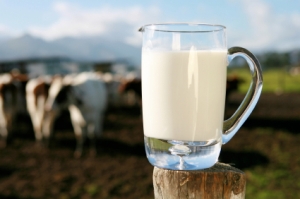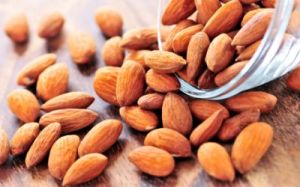Milk Madness
 This topic always seems to cause a bit of controversy—don’t worry, I am already aware. With so many options out there these days, such as almond milk, soy milk, whole milk, vitamin D-fortified milk and skim milk, what is the healthiest form of this classic dairy (or now non-dairy) beverage?
This topic always seems to cause a bit of controversy—don’t worry, I am already aware. With so many options out there these days, such as almond milk, soy milk, whole milk, vitamin D-fortified milk and skim milk, what is the healthiest form of this classic dairy (or now non-dairy) beverage?
I’ll be up front and tell you I’m not going to give a definite right answer in this post. There is simply too much conflicting information to come to a sound, all-encompassing conclusion. However, I will present some evidence and express my own view of the milk controversy, and I encourage you to base your own conclusions on the proof within the pudding (or pudding’s non-dairy form).
Almond milk: too good to be true?
When I first came across almond milk, I jumped for joy at the idea of drinking my favorite snack in liquid form. I could pour its sweet goodness over my granola, use it in my oatmeal or blend it in a delicious fruit smoothie. What could possibly be the downside of almond milk? After all, it’s just blended up almonds, right?
Wrong. For some reason, I completely avoided the nutritional label and existing research on this popular “health” beverage before I started using it as a milk alternative.
So what’s the problem? Well, if you look at the Almond Breeze (original flavor) ingredients, you’ll find the second ingredient listed is evaporated cane juice (a popular “health food” sweetener). I’m no fool—I know milk has natural sugars, but what is this sweetener doing in my milk?
If you’re not sure how to interpret the good, bad and ugly of this evaporated cane juice substance, consider a fun little quote from Judy Sanchez, a spokesperson for the U.S. Sugar Corp. (via NPR): “All sugar is evaporated cane juice. They just use that for a natural-sounding name for the product.”
Ok, easy enough. I’m not a big fan of added sugar, so I’ll just buy the unsweetened version of my favorite almond milk. BUT (you knew there’d be a ‘but’ coming), consider a cautionary word from the American Academy of Pediatrics on how the calcium from non-lactose milk alternatives is actually absorbed. After all, what’s the point of drinking these nutrient-fortified foods and beverages if our bodies don’t fully reap the benefits?
 “Recent evidence indicates that dietary lactose enhances calcium absorption and, conversely, that lactose-free diets result in lower calcium absorption. Thus, lactose intolerance (and lactose-free diets) theoretically may predispose to inadequate bone mineralization.” (Pediatrics. 2006 Sep;118(3):1279-86.)
“Recent evidence indicates that dietary lactose enhances calcium absorption and, conversely, that lactose-free diets result in lower calcium absorption. Thus, lactose intolerance (and lactose-free diets) theoretically may predispose to inadequate bone mineralization.” (Pediatrics. 2006 Sep;118(3):1279-86.)
If dairy products offer better bioavailability of nutrients compared to plant-based beverages (including almond milk, soy milk, rice milk, etc.), why vouch for the alternatives if you don’t have to? In other words, if it ain’t broke, why fix it?
The skinny on skim
Here in America, we’re known for our fat. Obesity continues to burden one in three U.S. adults, according to the Centers for Disease Control and Prevention, so one logical solution involves removing the fat from our diets. Eat less fat, be less fat. Makes sense.
But in reality, that logic is completely wrong. There’s a reason our population has consumed fat all of these years—we need it for nutrient absorption. As the segment from Pediatrics revealed above, calcium in milk is better absorbed in its natural, lactose-containing form. But also, keeping the fat within milk provides the body with essential fatty acids, and it also assists in the dissolving/absorbing process of fat-soluble vitamins and essential nutrients. (Am J Clin Nutr. 2004 Sep;80(3):550-9.)
One valuable piece of information I took away from my college class on Human Nutrition is the fact that there is more to eating than simply consuming. After food (or a beverage, in this case) is consumed, there’s an entire digesting, absorbing, energy-storing process that goes along with it, which is critical to maintain a healthy body. The bottom line: it’s just as important for people to ensure their bodies can properly absorb and digest healthy foods (and drinks), as it is to actually consume them. For example, if you’re eating leafy green after leafy green and never dressing it with a bit of fat to go along with, you may not be doing your body nearly as much good as you think.
Whole milk for whole health
 Now that we’ve gone over the importance of fat and consuming foods/drinks in their natural forms, you can probably guess that whole milk is my dairy beverage of choice.
Now that we’ve gone over the importance of fat and consuming foods/drinks in their natural forms, you can probably guess that whole milk is my dairy beverage of choice.
This form of milk allows the body to fully digest the protein and absorb the calcium, vitamin A and vitamin D available. Plus, it doesn’t taste like straight water with a dash of milk—an annoying trait of skim milk varieties.
“But won’t I die of heart failure with all that cholesterol?!” NO, silly Americans. I realize we’ve been bombarded with information indicating that fat-free is the healthy way to live. My advice is to look at some actual studies on the association of saturated fat and cardiovascular disease. You may just find that this supposed link has done nothing but cause a national fat phobia, even though large epidemiologic studies have shown no significant evidence concluding saturated fat is associated with an increased risk of heart disease or stroke (Am J Clin Nutr. 2010 Mar;91(3):535-46.)
If you’re still feeling uneasy about adding fat to your diet, consider reading the Top 8 Reasons Not to Fear Saturated Fats, written by a medical student/personal trainer who really hits the nail on the head with his post. And remember, food in its natural form is always the best option among today’s slew of “health food” products.

In God we trust.